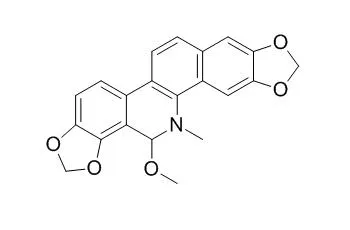| In vitro: |
| Eur Rev Med Pharmacol Sci. 2012 Jul;16 Suppl 3:121-5. | | Anti-inflammatory effects of Hylomecon hylomeconoides in RAW 264.7 cells.[Pubmed: 22957426] |
Papaveraceae serve as a rich source of various alkaloids which have anti-inflammatory effect.
METHODS AND RESULTS:
In this study, we investigated the effect of Hylomecon hylomeconoides ethanol extract (HHE) on lipopolysaccharide (LPS)-induced NO and interleukin-6 (IL-6) production in RAW 264.7 cells.
HHE inhibited LPS-induced NO and IL-6 production. Moreover, HHE suppressed the phosphorylation of ERK1/2 and p38 in LPS-induced RAW 264.7 in a dose-dependent manner. Furthermore, major constituents, dihydrosanguinarine and 6-Methoxydihydrosanguinarine, of the chloroform-soluble extract were analyzed.
CONCLUSIONS:
Taken together, the results of this study indicate that the anti-inflammatory effects of HHE may occur via the inhibition of NO and IL-6 expression through the down-regulation of MAP kinase (ERK1/2, p38) phosphorylation in RAW 264.7 cells. | | Appl Biochem Biotechnol. 2010 Apr;160(8):2467-74. | | Antibacterial activity of Hylomecon hylomeconoides against methicillin-resistant Staphylococcus aureus.[Pubmed: 19578993 ] | Methicillin-resistant Staphylococcus aureus (MRSA) is serious clinical urgent problems worldwide.
METHODS AND RESULTS:
In the present study, the antibacterial activity of Hylomecon hylomeconoides was investigated. The EtOH extract and its fraction (n-hexane, CH(2)Cl(2), EtOAc, and H(2)O) were investigated against MRSA. The most active extract (CH(2)Cl(2)) led to the isolation of 6-Methoxydihydrosanguinarine (6-MS), 6-acetonylhydrosanguinarine, and dihydrosanguinarine.
These compounds were very active against MRSA strains with minimum inhibitory concentrations (MICs) ranging from 1.95 to 250 microg/ml. Our study did however focus on 6-MS as it appeared to be the most active with MICs in the range of 1.9 to 3.9 microg/ml.
CONCLUSIONS:
These results encourage us to think that 6-MS can be used as a natural antibacterial agent. | | Biol Pharm Bull. 2002 Dec;25(12):1651-4. | | Inhibitory effect of isoquinoline alkaloids on movement of second-stage larvae of Toxocara canis.[Pubmed: 12499659] | To find new anthelmintics against parasites living in host tissues, we used an in vitro assay to screen isoquinoline alkaloids for nematocidal activity on the larva of dog roundworm, Toxocara canis. To evaluate the efficacy of anthelmintics in vitro, Tsuda et al. previously introduced the concept of Relative Mobility (RM) of Toxocara larvae.
METHODS AND RESULTS:
After improvement of the assay system using image data processing, we generated a new index, RM(50), the concentration at which RM=50%. However, except for pyrantel, the RM(50) of most existing anthelmintics could not be calculated because of low activity. Of the isoquinoline alkaloids tested, emetine, sanguinarine, 6-Methoxydihydrosanguinarine (6-MS), chelerythrine and berberine showed strong nematocidal activities. However, these compounds were highly cytotoxic; thus, the prospect of their direct application is low. We then tested the cytotoxicity (IC(50)) of other isoquinoline alkaloids in HL60 tissue-culture cells.
We continued our search for new anthelmintics by examining in detail the relationship between RM(50) and IC(50).
CONCLUSIONS:
We determined that an ideal target compound would exhibit a low RM(50)/IC(50) ratio. Allocryptopine, dehydrocorydaline and papaverine were identified as potentially effective anthelmintics. |
|






 Cell. 2018 Jan 11;172(1-2):249-261.e12. doi: 10.1016/j.cell.2017.12.019.IF=36.216(2019)
Cell. 2018 Jan 11;172(1-2):249-261.e12. doi: 10.1016/j.cell.2017.12.019.IF=36.216(2019) Cell Metab. 2020 Mar 3;31(3):534-548.e5. doi: 10.1016/j.cmet.2020.01.002.IF=22.415(2019)
Cell Metab. 2020 Mar 3;31(3):534-548.e5. doi: 10.1016/j.cmet.2020.01.002.IF=22.415(2019) Mol Cell. 2017 Nov 16;68(4):673-685.e6. doi: 10.1016/j.molcel.2017.10.022.IF=14.548(2019)
Mol Cell. 2017 Nov 16;68(4):673-685.e6. doi: 10.1016/j.molcel.2017.10.022.IF=14.548(2019)